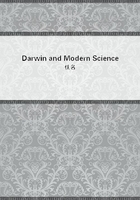
第106章
To present any adequate account of the palaeontological record from the evolutionary standpoint, would require a large volume and a singularly unequal, broken and disjointed history it would be. Here the record is scanty, interrupted, even unintelligible, while there it is crowded with embarrassing wealth of material, but too often these full chapters are separated by such stretches of unrecorded time, that it is difficult to connect them. It will be more profitable to present a few illustrative examples than to attempt an outline of the whole history.
At the outset, the reader should be cautioned not to expect too much, for the task of determining phylogenies fairly bristles with difficulties and encounters many unanswered questions. Even when the evidence seems to be as copious and as complete as could be wished, different observers will put different interpretations upon it, as in the notorious case of the Steinheim shells. (In the Miocene beds of Steinheim, Wurtemberg, occur countless fresh-water shells, which show numerous lines of modification, but these have been very differently interpreted by different writers.)The ludicrous discrepances which often appear between the phylogenetic "trees" of various writers have cast an undue discredit upon the science and have led many zoologists to ignore palaeontology altogether as unworthy of serious attention. One principal cause of these discrepant and often contradictory results is our ignorance concerning the exact modes of developmental change. What one writer postulates as almost axiomatic, another will reject as impossible and absurd. Few will be found to agree as to how far a given resemblance is offset by a given unlikeness, and so long as the question is one of weighing evidence and balancing probabilities, complete harmony is not to be looked for. These formidable difficulties confront us even in attempting to work out from abundant material a brief chapter in the phylogenetic history of some small and clearly limited group, and they become disproportionately greater, when we extend our view over vast periods of time and undertake to determine the mutual relationships of classes and types. If the evidence were complete and available, we should hardly be able to unravel its infinite complexity, or to find a clue through the mazes of the labyrinth. "Our ideas of the course of descent must of necessity be diagrammatic." (D.H. Scott, "Studies in Fossil Botany", page 524. London, 1900.)Some of the most complete and convincing examples of descent with modification are to be found among the mammals, and nowhere more abundantly than in North America, where the series of continental formations, running through the whole Tertiary period, is remarkably full. Most of these formations contain a marvellous wealth of mammalian remains and in an unusual state of preservation. The oldest Eocene (Paleocene) has yielded a mammalian fauna which is still of prevailingly Mesozoic character, and contains but few forms which can be regarded as ancestral to those of later times. The succeeding fauna of the lower Eocene proper (Wasatch stage) is radically different and, while a few forms continue over from the Paleocene, the majority are evidently recent immigrants from some region not yet identified. From the Wasatch onward, the development of many phyla may be traced in almost unbroken continuity, though from time to time the record is somewhat obscured by migrations from the Old World and South America. As a rule, however, it is easy to distinguish between the immigrant and the indigenous elements of the fauna.
From their gregarious habits and individual abundance, the history of many hoofed animals is preserved with especial clearness. So well known as to have become a commonplace, is the phylogeny of the horses, which, contrary to all that would have been expected, ran the greater part of its course in North America. So far as it has yet been traced, the line begins in the lower Eocene with the genus Eohippus, a little creature not much larger than a cat, which has a short neck, relatively short limbs, and in particular, short feet, with four functional digits and a splint-like rudiment in the fore-foot, three functional digits and a rudiment in the hind-foot. The forearm bones (ulna and radius) are complete and separate, as are also the bones of the lower leg (fibula and tibia). The skull has a short face, with the orbit, or eye-socket, incompletely enclosed with bone, and the brain-case is slender and of small capacity. The teeth are short-crowned, the incisors without "mark," or enamel pit, on the cutting edge;the premolars are all smaller and simpler than the molars. The pattern of the upper molars is so entirely different from that seen in the modern horses that, without the intermediate connecting steps, no one would have ventured to derive the later from the earlier plan. This pattern is quadritubercular, with four principal, conical cusps arranged in two transverse pairs, forming a square, and two minute cuspules between each transverse pair, a tooth which is much more pig-like than horse-like. In the lower molars the cusps have already united to form two crescents, one behind the other, forming a pattern which is extremely common in the early representatives of many different families, both of the Perissodactyla and the Artiodactyla. In spite of the manifold differences in all parts of the skeleton between Eohippus and the recent horses, the former has stamped upon it an equine character which is unmistakable, though it can hardly be expressed in words.